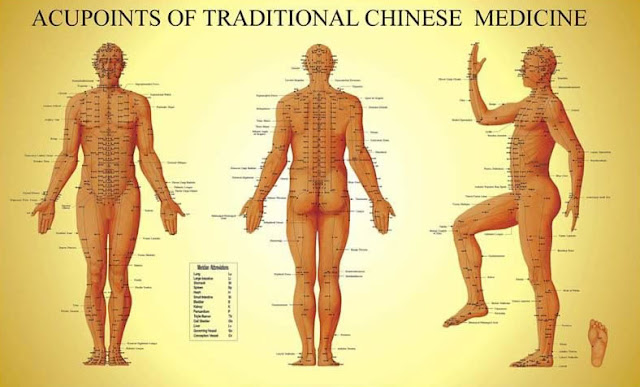"Acupuncture meridians are traditionally believed to comprise channels that connect the surface of the body with internal organs. Twelve primary meridians are believed to be located bilaterally in the body. The left and right meridians are symmetrical and influence each other through the interconnected meridian channels [1–4]. A network of meridian channels is believed to be located within soft connective tissues. Traditional Chinese medicine (TCM) has extensively described the related normal physiological functions, pathological conditions, transmission of the senses, and possible disease mechanisms [5]. The mechanisms of acupuncture remain poorly understood and require further investigation with scientific methods to explore the nature of meridian lines and acupuncture points. It is generally assumed that measuring the electrical conductivity at various meridians provides data relevant to the so called “meridian energy" "Wave-Induced Flow in Meridians Demonstrated Using Photoluminescent Bioceramic Material on Acupuncture Points
C. Will Chen https://www.ncbi.nlm.nih.gov/pmc/articles/PMC3838801/
Blaschko’s Lines
Share|
The lines of Blaschko are a pattern of lines on the skin that represent the developmental growth pattern during epidermal cell migration. The lines are distinguished from other morphological lines of the skin and do not represent vascular, lymphatic or nervous structures. Typically these lines are not visible; however, certain inherited and acquired diseases of the skin follow Blaschko’s lines.
Blaschko’s lines were originally described by Dr. Alfred Blaschko in 1901 when he examined over 140 patients with linear skin lesions that followed similar patterns. A diagram of the distribution pattern of these lines has since been drawn and is now referred to as the lines of Blaschko.
Blaschko’s lines follow a V-shape over the upper spine, an S-shape over the abdomen, an inverted U-shape from the breast to the upper arm, and perpendicular lines up and down the arms and legs. They also appear on the head and neck in a less well-defined manner.
The following congenital, acquired and genetic diseases follow Blaschko’s lines:
Congenital Skin Disorders
how would the meridians look if the acupuncture points are connected horizontally in a curve ?
Bart syndrome
Epidermal Nevus
Hypomelanosis of Ito
Inflammatory linear verrucous epidermal nevus
Linear and whorled nevoid hypermelanosis
Linear basal cell nevus
Linear Darier’s disease
Linear eccrine nevi
Linear epidermolytic hyperkeratosis
Linear nevus comedonicus
Linear porokeratosis of Mibelli
Nevus corniculatus
Nevus depigmentosus
Nevus sebaceous of Jadassohn
Relapsing linear acantholytic dermatosis
Syringocystadenoma papilliferum
Unilateral nevoid basal cell carcinoma syndrome
Acquired Skin Disorders
Extragenital lichen sclerosus
Generalized lichenoid drug eruption
Lichen striatus
Linear atrophoderma of Moulin
Linear fixed drug eruption
Linear lichen planus
Linear mucinoses and mycosis fungoides
Linear psoriasis
Linear scleroderma
Lichen striatus
Lupus erythematosus
Segmental vitiligo
Genetic Skin Disorders
CHILD syndrome
Conradi-Hunermann syndrome
Familial cutaneous amyloidosis, Partington type
Focal dermal hypoplasia
Incontinentia pigmentii
Melanotic macules of McCune-Albright syndrome
Menke’s syndrome
Oro-facial-digital syndrome, type I
Segmental ash leaf spot
X-linked hypohidrotic ectodermal dysplasia
C. Will Chen https://www.ncbi.nlm.nih.gov/pmc/articles/PMC3838801/
Blaschko’s Lines
Share|
The lines of Blaschko are a pattern of lines on the skin that represent the developmental growth pattern during epidermal cell migration. The lines are distinguished from other morphological lines of the skin and do not represent vascular, lymphatic or nervous structures. Typically these lines are not visible; however, certain inherited and acquired diseases of the skin follow Blaschko’s lines.
Blaschko’s lines were originally described by Dr. Alfred Blaschko in 1901 when he examined over 140 patients with linear skin lesions that followed similar patterns. A diagram of the distribution pattern of these lines has since been drawn and is now referred to as the lines of Blaschko.
Blaschko’s lines follow a V-shape over the upper spine, an S-shape over the abdomen, an inverted U-shape from the breast to the upper arm, and perpendicular lines up and down the arms and legs. They also appear on the head and neck in a less well-defined manner.
The following congenital, acquired and genetic diseases follow Blaschko’s lines:
Congenital Skin Disorders
how would the meridians look if the acupuncture points are connected horizontally in a curve ?
Bart syndrome
Epidermal Nevus
Hypomelanosis of Ito
Inflammatory linear verrucous epidermal nevus
Linear and whorled nevoid hypermelanosis
Linear basal cell nevus
Linear Darier’s disease
Linear eccrine nevi
Linear epidermolytic hyperkeratosis
Linear nevus comedonicus
Linear porokeratosis of Mibelli
Nevus corniculatus
Nevus depigmentosus
Nevus sebaceous of Jadassohn
Relapsing linear acantholytic dermatosis
Syringocystadenoma papilliferum
Unilateral nevoid basal cell carcinoma syndrome
Acquired Skin Disorders
Extragenital lichen sclerosus
Generalized lichenoid drug eruption
Lichen striatus
Linear atrophoderma of Moulin
Linear fixed drug eruption
Linear lichen planus
Linear mucinoses and mycosis fungoides
Linear psoriasis
Linear scleroderma
Lichen striatus
Lupus erythematosus
Segmental vitiligo
Genetic Skin Disorders
CHILD syndrome
Conradi-Hunermann syndrome
Familial cutaneous amyloidosis, Partington type
Focal dermal hypoplasia
Incontinentia pigmentii
Melanotic macules of McCune-Albright syndrome
Menke’s syndrome
Oro-facial-digital syndrome, type I
Segmental ash leaf spot
X-linked hypohidrotic ectodermal dysplasia


No comments:
Post a Comment